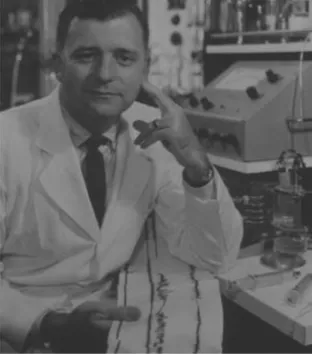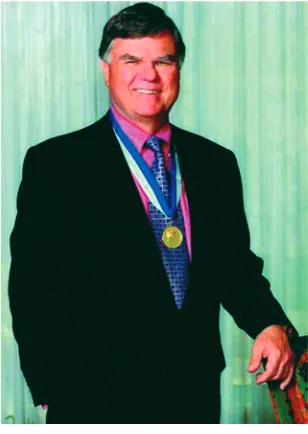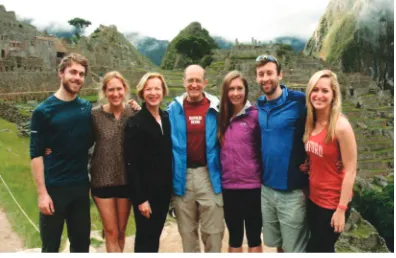American Physicians George M. Kober Medal
Giving back
Elizabeth G. Nabel
J Clin Invest.
2014;
124(7)
:2831-2835.
https://doi.org/10.1172/JCI77286
.
Thank you, Gene. To be honest, I never thought I would be considered for this award. I was
totally surprised when Warner Greene called me. I am deeply honored, and I thank you,
Larry Jameson, the AAP, my colleagues, and of course my family. Dr. Eugene Braunwald I
cannot begin to express my gratitude to Gene Braunwald. Gene, you have been my hero,
since 1981, when as an intern, I presented cases to you in morning report or rounds. Your
commitment, your intelligence, your standards, and your values have shaped and
transformed my life in medicine. Several years ago, Gary and I hosted Gene at our home in
DC, along with the Sarnoff fellows. Chris and Elisa were in high school at the time. I recall
introducing Gene to Chris and indicating that Gene was his academic grandfather. I said to
Chris, “If Gene didn’t have such a terrific training program, your Dad and I would never have
met!” So, Elisa and Katherine, meet your academic grandfather! Gene, you have more
academic grandchildren than you can imagine! But seriously, when I finished reading Tom
Lee’s book (Eugene Braunwald and the Rise of Modern Medicine) about you and your life
in medicine, I was dumbfounded (Figure 1). I sat back, stunned. I realized that every
decision that I have made during […]
AAP Kober Medal Acceptance
Find the latest version:
Acceptance of the 2014 Association of American Physicians George M. Kober Medal
Giving back
Elizabeth G. Nabel
Thank you, Gene. To be honest, I never thought I would be considered for this award. I was totally surprised when Warner Greene called me. I am deeply honored, and I thank you, Larry Jameson, the AAP, my colleagues, and of course my family.
Dr. Eugene Braunwald
I cannot begin to express my gratitude to Gene Braunwald. Gene, you have been my hero, since 1981, when as an intern, I presented cases to you in morning report or rounds. Your commitment, your intelligence, your standards, and your values have shaped and transformed my life in medicine.
Several years ago, Gary and I hosted Gene at our home in DC, along with the Sarnoff fellows. Chris and Elisa were in high school at the time. I recall introduc-ing Gene to Chris and indicatintroduc-ing that Gene was his academic grandfather. I said to Chris, “If Gene didn’t have such a terrific training program, your Dad and I would never have met!” So, Elisa and Katherine, meet your academic grand-father! Gene, you have more academic grandchildren than you can imagine!
[image:2.585.384.540.509.686.2]But seriously, when I finished reading Tom Lee’s book (Eugene Braunwald and the Rise of Modern Medicine) about you and your life in medicine, I was dumbfounded (Figure 1). I sat back, stunned. I realized that every decision that I have made dur-ing my life in medicine stems from the knowledge, the values, and the wisdom you gave to me. Your impact on multiple generations is durable and profound.
My parents and early years
As Gene described, I grew up in a mod-est, conservative Midwestern home, with very loving parents. My three siblings and I learned from them the value of hard work, the importance of family and an education, and the responsibility to
give back to society. But, of course, that many years ago in the 1960s and ’70s, it was pretty tough for a young woman to find her scientific voice in a conservative environment. My parents were highly supportive and proud — but perhaps sur-prised — when I uprooted to New York City and created a medical life for myself. But I took the chance, and I am glad I did.
As a medical student, I became interested in clinical research — observations starting with a patient — and asking fundamental questions about disease mechanisms and pathophysiology. One of the themes in my career has been to start with the clini-cal setting, take an observation and raise a question about a patient, and use the best technique possible to investigate the ques-tion. At Cornell, I conducted my first clini-cal study on the pathophysiology of recom-binant factor VIII therapy for hemophilia with Margaret Hilgartner. As a mother of three and married to a physician, she was also a fantastic role model.
I had wanted to be a surgeon, but the Chief of Surgery at Cornell, G. Tom Shires, a Texan, made it very clear that there was no room in surgery for women. So I chose the next best field, cardiology, and there was no place better to train as a physician-scientist in cardiology than at the Brigham.
The Brigham
The Brigham transformed my life. I never thought I would derive so much per-sonal and professional satisfaction from being a physician, but this is the gift that the Brigham gave me through Drs. Gene Braunwald and Marshall Wolf.
As a cardiology fellow, I became very interested in vascular biology, in particu-lar atherosclerosis and restenosis, due to my care of cardiac patients and interest in interventional cardiology. Robert Furch-gott had just described EDRF, endotheli-al-derived relaxing factor, later known to be nitric oxide. There was terrific collab-oration and dialogue between clinicians and scientists at the Brigham, between Gene, Tom Smith, Wayne Alexander, and my colleagues Peter Ganz and Andrew Sel-wyn in the cath lab. I began clinical stud-ies of endothelial and vascular smooth
muscle function in the cardiac cath lab and carried those observations over to the basic laboratory in work with Tom Smith. I enjoyed the to-and-fro bedside-to-bench-to-bedside research very much.
On a personal side, I met Gary there, our son Chris was born there, and now it is my turn to give back to the Brigham, to Part-ners, our partnership with the MGH, and the larger world of academic medicine and biomedical research. I am so proud and eager to have this opportunity to serve the Brigham. I’ve often described it as going from “resident to president.” My grati-tude goes to my chief colleagues; it is an extraordinary pleasure to work with them to advance the academic mission of the Brigham (Figure 2).
Dr. William N. Kelley
Then, fate brought us to Ann Arbor. Actu-ally, it wasn’t fate; it was Bill Kelley. Bill was persistent; later he revealed his strat-egy of offering 10% more in salary than Gene Braunwald did, and he was success-ful in recruiting quite a few of us from Bos-ton. But Bill, little did we know that when you recruited Gary and me to Ann Arbor in 1987, that we would develop a love affair for all things GO BLUE!
Conflict of interest: The author has declared that no conflict of interest exists.
Citation for this article: J Clin Invest. 2014; 124(7):2831–2835. doi:10.1172/JCI77286. This article is adapted from a presentation at the ASCI/AAP Joint Meeting, Chicago, Illinois, USA, April 26, 2014.
Figure 1
ment. I wanted to set up a basic science lab to investigate the molecular basis of vascular disease. Bill, you took on a risk with me, providing me with $50,000 a year for two years. I received my first R01 at the end of the second year. That was a crucial time of professional growth for me, scien-tifically, and you were a big part of it. So thank you, Bill!
One of my greatest pleasures was my laboratory work at Michigan, where we developed gene transfer techniques to investigate the pathophysiology of vas-cular cell growth and designed models of biologics combined with devices to treat vascular disease. I had the great pleasure of working with many talented, bright students, fellows, and postdocs in my lab, many of whom are now very suc-cessful physician-scientists in academia and industry. I am very proud of their successes. Indeed, as many in this room know, mentoring is one of our profes-sion’s greatest pleasures. I am so pleased There was a lot of star power in Bill’s
Department of Medicine and in particular his HHMI unit at the time — Drs. Tachi Yamada, David Ginsburg, Francis Collins, Craig Thompson, Jeff Leiden, Mike Par-macek, Andy Feinberg, and Jim Wilson. We were just “Kelley’s kids” (Figure 3).
Bill, you supported me at a very critical point in my career. My initial job was as an interventional cardiologist. In the late 1980s, percutaneous coronary interven-tion (PCI) and intracoronary thrombolyt-ics for acute myocardial infarction (MI) were on an exponential rise. As much as I enjoyed taking care of my patients in the cath lab, I was also very perplexed by the 40% of patients who recurred at that time with restenosis, a regrowth of vascular smooth muscle cells within the injured lesion. We had no clear response — repeat PCI, shaving, roto rooter; mechanical interventions weren’t working. I sought to understand the biology and use the biology to establish a more effective
treat-Figure 2
[image:3.585.45.541.85.378.2]I am fortunate to work with truly outstanding chairs of our 15 departments at Brigham and Women’s Hospital. Top row: Dr. David A. Silbersweig, Psychiatry; Dr. Terrie E. Inder, Pediatric Newborn Medicine; Dr. Steven E. Seltzer, Radiology; Dr. Charles A. Vacanti, Anesthesia; Dr. Martin A. Samuels, Neurology; and Dr. Michael J. Zinner, Surgery. Middle row: the entrance to the Peter Bent Brigham Hospital; Dr. Robert L. Barbieri, Obstetrics and Gynecology; Dr. E. Antonio Chiocca, Neurosurgery; Dr. Joseph Loscalzo, Internal Medicine; and Dr. Thomas S. Kupper, Derma-tology. Bottom row: Dr. Jeffrey A. Golden, Pathology; Dr. Thomas S. Thornhill, Orthopedics; Dr. Jay R. Harris, Radiation Oncology; Dr. Ross D. Zafonte, Physical Medicine and Rehabilitation; and Dr. Ron M. Walls, Emergency Medicine.
Figure 3
[image:3.585.44.198.481.698.2]laborator, policy convener, coconspirator in genomics, dbGaP, and progeria; Tony and Chris Fauci, our dear family friends, as each of our three kids were schoolmates — Tony was a great Institute director mentor and a phenomenal intellectual colleague for Gary; Harold Varmus, intellectual com-panion and a reliable source for provoca-tive conversation; Tom Insel, Story Landis, Alan Guttmacher, Eric Green, and Griff Rodgers, thank you; and to my successor, Gary Gibbons, all my very best.
As NHLBI director, I learned very quickly how to get things done in the government. I chose to use my leadership role to do things differently — often deviating from the norm — for positive outcomes.
Along with advocating for scientific issues like women’s heart health, global health, and regenerative medicine, I spent a lot of time discussing biomedical research funding with members of Congress and their staff. I con-tinued to make the case for the high value of basic, translational, and clinical research — what we do at academic medical centers.
I firmly believe that academic medical cen-ters are the cornerstone of evidence-based advances in health. So after the NIH, I wanted to return to academia and lead an outstand-ing academic medical center. Our task is not an easy one, and for those of us in this room who are passionate about our mission, we will advocate to preserve, protect, and grow biomedical research in this country.
Drs. Helen Taussig and Helen Ranney
These two distinguished physician-scientists precede me as the only two women who have been honored with the Kober Medal, in 1987 and 1997, respectively many scientists in the field, who
collec-tively engaged in a tale of gene discovery, then used a foundation of protein bio-chemistry, cutting-edge cell biology, and a mouse model of progeria to develop a drug treatment. This was an amazing, ded-icated, and creative interdisciplinary team, who then began a series of clinical trials with progeria kids from around the world. Clinical research just doesn’t get any better, particularly when it is focused on an extra-ordinary group of children.
As NHLBI director, I learned a tremen-dous amount from my colleagues and role models at the NIH (Figure 5): Elias Zerhouni, he took a bet on me as NHLBI director and was a fantastic mentor; Francis Collins, a great friend, research col-that Dr. Santhi Ganesh is here today.
Santhi was a fellow and postdoc with me at the NHLBI and now is an assistant professor at the University of Michigan, studying the genetics of vascular disease.
My NIH colleagues and friends
[image:4.585.50.365.84.264.2]We had a pretty idyllic life in Ann Arbor, but then it was on to the NIH. Our won-derful colleagues at NIH became our next family. I continued my research in vascular biology in the intramural program at the NHLBI, and in 2005, it took an interesting turn, when Dr. Francis Collins asked my lab to join his in investigating the cardio-vascular mechanisms of Hutchinson-Gil-ford progeria syndrome. Francis had just discovered the genetic cause, a spontane-ous mutation in the lamin A gene. But it was Sam Berns, the son of Leslie Gordon and Scott Berns, a seven-year-old boy with progeria that captured my scientific atten-tion and my heart (Figure 4). This led to a fantastic scientific collaboration with
Figure 4
[image:4.585.222.543.548.742.2]My research and my outlook on life have been wonderfully influenced by the Berns family, from left to right, Dr. Scott D. Berns, Sampson “Sam” Gordon Berns (deceased), and Dr. Leslie B. Gordon.
Figure 5
we have continued to experience together this thrilling ride called life. Gary, you understand me in ways for which I am so thankful. I couldn’t ask for a better partner!
And thank you to our children, Chris, Elisa, and Katherine (Figure 7). You know you are the joy of our lives. Thanks for coming from afar to be with your mom and dad. As children of physician- scientists, you have had to put up with a lot. Our long hours, our frequent traveling, our moves — but you have done all this with great patience and tenacity. Dad and I are so very proud of you, as your grandfather Dick would be as well, and our only hope is that you find the joy and satisfaction in your own families and life’s work that we have had in ours. We will always support you, no matter what it takes. We hope you will have opportunities equivalent to those we have in which to express your intellectual curios-ity and to live your passion.
To my brother and sister-in-law, Tom and Max, thank you for being here today. Tom, you and I were the beneficiaries of our dad’s interest in science, and we have been served well.
So to Gene, Bill, my trainees, my NIH col-leagues, my Brigham family, and my own family, Gary, Chris, Elisa, and Katherine, thank you!
sional career at UCSD, was president of the AAP from 1984 to 1985, and left a leg-acy of translational research. I am indebted to what these two women gave to me through the trails they blazed. Because of their commitment and scientific passion and their example, women like me got a chance. I see my job now to “pay it forward” to women in the early and middle phases of their personal and profes-sional career journeys.
Yet, it makes me sad to think that neither Helen married nor had a family — these are of enormous value and joy for me, and frankly, I would not be where I am today without the love and support I receive from my husband and family.
My family
[image:5.585.42.257.83.229.2]Last, but not least, thank you to my hus-band, Gary. Hands down: my biggest win, my most precious gift in life has been Gary. Starting with our first date, which was memorable beyond belief, as we were held up at gunpoint in a Cambridge restaurant, (Figure 6). These women were true pioneers.
And what’s sometimes overlooked through the rosy lens of looking backwards is that being a pioneer is really, really hard.
Helen Taussig, who founded the field of pediatric cardiology and conceived the sur-gical fix for tetralogy of Fallot, did not have an easy time at all. Her mother died when she was nine, she had TB as a child, and then she struggled with severe dyslexia in a time when being a woman in the classroom was hard enough. She studied at Harvard Medical School and
Bos-ton University, although neither school allowed her to earn a degree. Apparently, she was not allowed to talk with her male classmates in his-tology class for fear of “contaminating” them! She completed her degree at Johns Hopkins in 1927, and the rest, as they say, is history.
Helen Ranney changed the face of hematology by elevating its then status from “internal dermatol-ogy” to a thriving space where research and clini-cal care go hand in hand. She was initially rejected by Columbia P&S in 1941, went to work as a research technician, and was accepted during the war when there were few men in medical school. She graduated in 1947. She spent her
profes-Figure 6
I am inspired by two Kober Medal recipients who went before me, Dr. Helen B. Taussig (left) and Dr. Helen M. Ranney (right).
Figure 7
[image:5.585.148.544.451.709.2]


